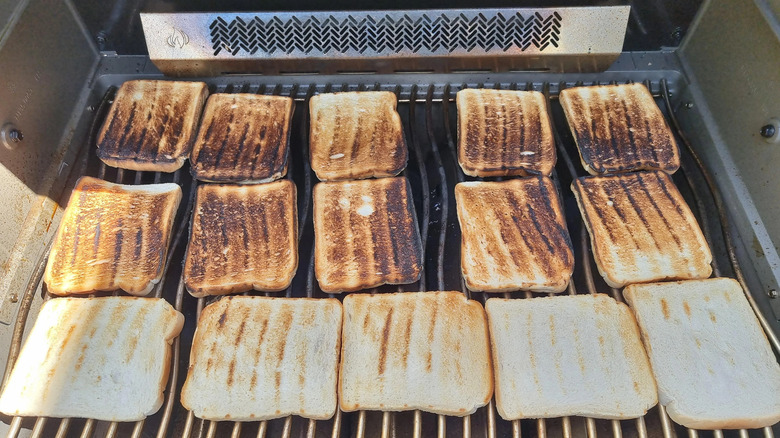The Genius Bread Hack For Finding Your Grill's Hot Spots
Anyone can light up a barbecue and get some burgers onto a picnic table, but the true grill-master knows there's more to this than just heating food over an open flame. If you want the best results from your gas grill, especially when you're working with expensive products, it pays to take the time to learn where its hot and cold spots are. Fail to get a handle on your temperature zones and temp-control, and you could end up with under- and overcooked food, featuring charred outsides and chilly insides.
It's hard to know how to find those hot spots, however, without sacrificing a few steaks, since you can't put your hand down on the grates to see where the heat (or cold) is collecting. Rather than wasting money on a few prime ribeye steaks, grab a loaf of cheap, sliced white bread while you're out shopping for barbecue supplies. You can use those slices to do an easy heat-spot check, which will give you much more temperature-control every time you fire up the grill in the future.
Spread the bread
Just like an oven, every gas grill has hot and cold spots, whether it's brand-new or has been on your back patio for years. Some burners run hotter than others, and sometimes, they get clogged from grease dripping down into the grill. Regardless, you can't know where the hot spots are unless you test the waters a little. The best way to do this is to use several slices of white bread spread across a hot grill to see what burns and what doesn't.
To pull off this bread experiment, fire up your gas grill and set all of the burners to high for about 15 minutes with the lid closed to get the grill grates very hot. Next, turn the burners down to medium and spread the slices of bread to cover the entire grilling area. Grill your slices for a minute or so and then flip them over with a pair of tongs to see the results. Make sure you keep the slices in the same spots as they were grilled on and, once you've flipped everything over, take note of where all the darkest spots are — those are your hot spots. Since you'll probably forget where they are as soon as you clear away the bread, take a quick picture of the grilled slices with your phone so you can look back on it whenever you grill, for the rest of the season.
How to use your new knowledge and your bread
Once you know your grill's hot and cold secrets, you can use them to your advantage. Set your grill up with two controlled grilling zones, based on the naturally hotter and cooler areas, every time you cook. The hot area should be around 500 degrees Fahrenheit so you can get a good, hard sear on the crust of your food. The cool area should be around 225 to 375 degrees Fahrenheit; after you sear your food in the hot area, move it over to the cooler zone to cook through without burning the outside. You can use this two-zone method for cooking everything from perfect steaks to whole fish.
It's a good idea to give your grill a bread-check each season, especially if you put it away for the winter. Things can change that affect the hot and cold zones, like burners getting clogged or briquettes shifting around. Plus, the photo you took last summer on your phone will get buried behind a year's worth of pictures, and you won't want to scroll back up to find it. You can also use this technique when you're grilling away from home, like at a vacation rental or a friend's house. As a bonus, each time you do your test, you'll get some grilled bread that you can use to make croutons for a salad or for sprinkling over some sides like grilled asparagus and zucchini.


